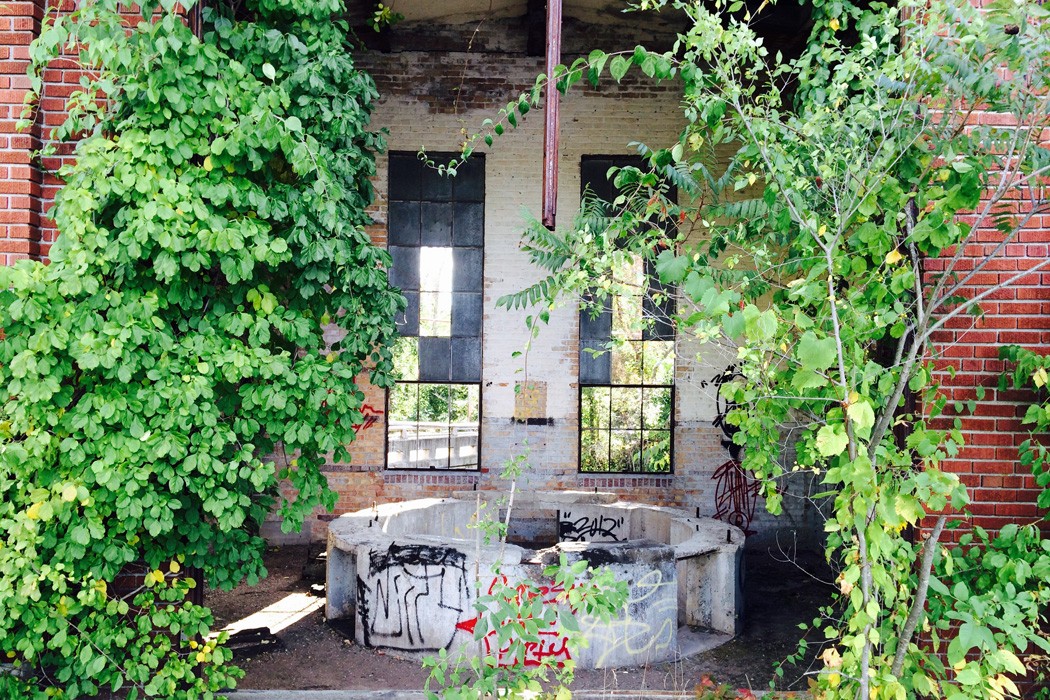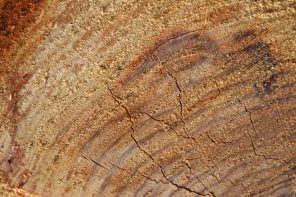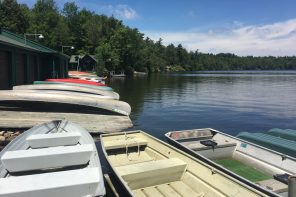It’s Hennen’s second world that engulfs me now, and at least here, the two are well met. From where I stand in the current, an inky cloud of minnows glides through the sandy shallows and a garrulous kingfisher chatters upstream from a sycamore limb. This, in an amber jewel of an urban stream that winds within easy earshot of cars, homes and people who scarcely seem to know that it exists.
It’s formally known as the Portage River, one of three that gives Three Rivers, Michigan, its name. I’m here to fish it on a hot, kiln dry August evening and of this much I’m certain. I’ll catch at least a dozen bass, maybe a pike or two, and most likely won’t see another soul while I’m at it. That’s been my experience for 43 years and for good reason. You can’t reach these holy waters without a struggle. As with any mortal entrance to paradise or perdition, there’s a guard at the gate to exact tribute.
Only it’s not St. Peter or Charon the boatman, but a gauntlet of poison ivy, stinging nettles, raspberry briers and some species of sprawling Eurasian vine that may well garrote my throat should I stand still long enough. I confront it all lightly clad, as if dressed for temple sacrifice: old shorts, Detroit Tigers t-shirt and duct-taped sneakers. A post-apocalyptic fashion sense reigns here — save those $500 bigshot waders for the Fortune 100 trout streams of Aspen.
From the street, I pick my way into the spiteful thicket armed only with a fishing rod to joust away the foliage. I stumble through thorn and bramble, each step its own trial. Finally comes the beloved river. With near orgasmic relief, the current’s cool rush soothes scratched shins, as well as a psyche over wrought by office servitude.
The river here, adjacent to a law office parking lot, winds like a big comma through a steep, wooded ravine. While not exactly a Midwestern Machu Pichu, the landscape does paint a striking picture of human conquest and natural renewal. One hundred yards upstream lies the gracefully aging Boys Dam. Fifty yards downstream stands the old powerhouse, a defunct hydro plant once powered by the millpond behind the dam. It hasn’t produced a volt of electricity since 1971. It does seem to generate energy of a curious kind no ammeter can measure, but more on that shortly.
The law office was once the headquarters of R.M. Kellogg Company. Until the early 1950s, it was one of the nation’s largest suppliers of mail-order bedding plants. My grandmother worked there sorting and packing plants. My father hoed weeds in the sandy farm fields near the river where the strawberries and chrysanthemums grew.
In a gesture of good citizenship, and no doubt product promotion, the company built a landscaped flower garden above the river. Visitors would drive hours to tour it and Kellogg Gardens appeared on state maps until the late 1970s. You still see its remains: a toothsome wall of jagged black stone; two small stone grottoes; a cement footbridge over a man-made stream long since run dry and overgrown with catalpa saplings and myrtle. The myrtle, a shiny green ground cover, has spread to cover perhaps a half-acre — an exotic and invasive species, yes, but it’s also one that, with maternal care, now holds soil in place on a steep, erosion-prone riverbank.
Yet this is all so much archaeological background noise to the reel task at hand. It’s live fish I’m after, and for that you need to wade the river, as it’s too narrow for a boat and too heavily wooded to cast from shore. So upstream I go, casting a gold spinner tipped with a treble hook. The spinner, no less than the dappled shade and delightful crunch of gravel underfoot, adds to the river aesthetic. When cast just so, on a flat trajectory, it lands with a metallic splash that sounds like coins dropped in a marble fountain.
Best of all, in the low, clear waters of summer you can see the fish strike.
Which a 15-inch smallmouth does in short order, just below the myrtled bank. First, he’s a black shadow that zooms from a submerged tree trunk, a U-boat ripple of dorsal fin for his wake. Then…whammo! Man meets fish, line and rod shudder, and the game’s on.
He streaks instinctively toward a dark tangle of silver maple roots beneath an undercut bank. Just barely do I steer him away from his favorite hiding spot into the open water.
Finally, after a few showy leaps and porpoise rolls, he tires and comes to heel. Once in hand, what a righteous specimen he proves to be: blackish brown above, olive bands and divinely golden rays aglimmer on his face and flanks. Then, with a defiant tail flip (the fishy version of a middle finger) he splashes back into the current unharmed.
For the fish, it’s a fight for life. For the human — who knows why, perhaps some limbic pleasure center that evolution forgot — the encounter brings deep and abiding satisfaction. That this drama played out in a shoe box wilderness makes it even more rewarding. A mower drones in the subdivision 50 yards away. Bassy hip-hop thumps from monster speakers in a black Chevy Caprice. At water’s edge, a 12-inch pipe juts from a tangle of brush, a rusty menace that once dumped God know what into the river.
Although it doesn’t do that now. You’re here and everything’s perfect. Nothing can harm you, no ill beset you. You’ve happily become a human metronome. Cast and reel, cast and reel, cast and reel…until every bad thought falls away like scales from the eyes of the blind man who Christ cured and sent to wash in the pool of Siloam.
That such peace would find me here is no surprise. I’ve fished nearly every foot of this 14-mile river, but hold this section in special regard. It’s where I learned to fish as I do and to think as I do. And much of that history began at the next bend in the river.
The defining moment comes where the waters widen for a commanding view of the dam. You know it’s coming, you hear the roar. Nonetheless, it never fails to feel as if you’ve stumbled on an unnamed waterfall in the north country.
The dam has been built on a scale that’s invitingly human. The water shimmers down in pellucid sheets over its mossy green face in a mesmerizing way that compels you to touch it. Thus enticed, you sidestep carefully in fast water over the low concrete apron to wade around in the root beer roil of the tail waters. It’s a child’s wading pool writ large, albeit a bit more hazardous. It’s no wonder my father would come here after a hot day on the Kellogg Farm to skinny dip with his friends.
An eternal mist– the Portage River atomized — hangs suspended over the lather. In the churn below, I catch my dozen bass quota and then some. Nothing monstrous, but able fighters all and as dusk sets in I’m sated. In late summer, you fish not just for immediate pleasure, but to store up the satisfaction of fishing against the cold bleakness to come. That I have done in this fetching little river gone wild in the city.
It’s a warm night, but the waning light signals early fall, a season that’s by nature melancholy. I’m here alone, but since most fishers are secretive misanthropes when it comes to sharing their honey holes, that’s hardly a reason to feel wistful. Then as I stood dripping on the shore, I realized that what troubled me was something more elemental: the fact that there were no boys at the Boys Dam.
I recall the days when we’d while away an afternoon here: swim, fish, scream, fight, throw rocks, carom around on a frayed rope tree swing. It had a Lord of the Flies feel about it. There were no adults; ours was a micro-kingdom ruled and policed by kids.
Not that it was all Norman Rockwell-sanctioned fun. It was the 70s, after all, so more than a few teens drank, smoked weed, and dropped LSD in the trippy woods. Yet the point is, we all knew and loved Boys Dam. As a wild, local place we felt a kinship with it that was our birthright.
In the span of two generations, that childhood knowledge and interest in the wild nearby has fallen off markedly. Adults my age are of course quick to blame the distractions of smart phones and satellite television for this disconnection from the natural world (even as we grow ever more enamored of our garage-door sized TVs and cell phones big enough to require holsters). Still, Nature Deficit Disorder, as so named by author Richard Louv, is a verifiable reality.
Public health researchers say the lack of self-directed outdoor play contributes to childhood obesity, diabetes, and ADHD. It’s been implicated in vitamin D deficiency, a problem that especially afflicts minority youth in urban settings where it’s unsafe to venture of out of doors. Beyond the physical benefits, natural outdoor play teaches kids social skills, creative problem solving, and self-regulation. It needn’t be grandiose: climbing trees, making mud pies, or building a fort from sticks all foster learning and growth.
Such activity is predicated on children having an outdoor place for that to happen. In Louv’s best seller Last Child in the Woods, it’s telling that when he asks a child why he prefers to play inside, the boy responds, “Because that’s where the electrical outlets are.”
When one views Boys Dam from that perspective, you begin to see what it could be and should be. For starters, public property, with access reopened that’s been denied since the land around it was sold to developers. It was an unofficial park before, so why not make it an official one now? In my mind’s eye, I could see a hiking trail, a footbridge over the ravine, a fishing dock, a boardwalk into the pond with a viewing platform for birding.
While we’re at it, let’s tear out the whole dam. Let the penned up lower Portage run free as it hasn’t since the early 1900s. Let the pike and walleyes migrate upstream again from the confluence of the St. Joseph River one mile south. Dredge out the tons of silt from Hoffman Pond that’s already created its own football field of an island.
The Michigan Department of Natural Resources would second that, as its now their policy to remove as many inoperable dams as possible. And for good reason. Of the state’s 2,600 dams, 90 percent will reach or exceed their design life by 2020, according to an American Society of Civil Engineers report. Further, in an age of mega-scale, nuclear and coal-fired power generation, hydro in Michigan has become a minor player. It produces only 1.5 percent of the state’s energy supply.
As for Boys Dam, six years ago, when my nephew Nick was an engineering student at Notre Dame, I “helped” with a research paper on small-scale hydro generation in Three Rivers (as in, I provided the name of a city engineer and county park director who he could call for information.) Based on projects for similar sized operations, he learned that a refurbished Boys Dam would require a $1 million fish ladder plus about another $1 million to refit the powerhouse with modern equipment.
Finally, I caught myself and stopped with the scheming. One shouldn’t let too much thinking ruin a good evening on the river. It’s exactly this kind of mental over-stimulation that makes me have to fish so much in the first place.
Rather than wade downstream to my car, I followed the kayak/canoe portage trail south toward the powerhouse and street. I’m nearly to the road when I stop in my tracks. No doubt it’s the heavenly pastiche of pink twilight, but there’s something about the powerhouse I hadn’t noticed before.
It’s actually an attractive, dignified building. It hearkens from an age when even a prosaic piece of architecture — a power plant — was built to enrich the public square. Wine red bricks, with several rows of corbeling near the top, provide staid ornamentation. Four banks of 12 foot-high windows flood the interior in natural light. Add a soaring, 20-foot ceiling and you have a structure with the regal verticality one expects to see in a house of worship. A blanket of bittersweet vines can’t conceal its classic lines.
Yet it’s inside, where every window has been shattered, and the turbine and generator hauled away, that the building evokes something otherworldly. Water still rushes in from the pond through a concrete sluice way. Except that where the turbine and generator once stood, there’s a gaping, round hole in the floor some nine feet across. Ten feet below that, as if in a primal basement flooded by a subterranean sea, there’s a three-foot diameter whirlpool.
It’s a frightening thing to stumble across in the twilight, I’ll tell you that. Through that ghastly hole, a vortex glows white as it roars away into nothingness. It may well pass through a portal into one of Tom Hennen’s other poetic worlds. It’s as if everything wild and mysterious about the river has gathered and concentrated itself here.
A bit spooked, I take a last fond look through the broken windows at the river. I can’t bear to leave it yet, so I scramble down the gravely, overgrown bank to where the powerhouse ledge meets the water.
On cast one, I land a chunky, 11-inch smallmouth, a fine fish and standard Portage River fare. On cast two, I’m shocked out of my everyday complacency.
For I have tied into a predator and he’s a big one: a northern pike, Esox Lucius in the Latin; a freshwater shark, a snaky, fearless fish with a dragon’s pointed snout and a mouth full of cartoonishly cruel teeth. He’s well over 30 inches and four inches across the shoulders when I pull him ashore. To remove a hook from a pike’s executioner’s mouth with bare fingers always makes me feel as if I’m one snap away from the emergency room.
And there’s more to come: a miraculous draught of fishes to be exact.
I’m casting now into the boiling water where the draft tube (fed by the vortex) bubbles up from below. It must be 10 or 12 feet deep, the bottom scoured out by the constant discharge. Here the fish lie in cool darkness, invigorated by the oxygenated water that feeds them a steady diet of nymphs, minnows, crayfish, frogs, snakes, maybe even fuzzy ducklings, and whatever else the food processor whirlpool flushes their way.
To feed and hold all day against the current has made them big and strong. They strike with fearless aggression like wilderness fish that haven’t seen a lure for awhile. It’s dark now, but I can see a white flash of abdomen as the heavy bass leap and land with a belly flop smack as only big fish can.
I have clearly roused the temple guards, Piscis Leviticus in the pig Latin, who minister at the powerhouse gates. I hook five big fish one after the other, in a pool hemmed in by a downed treetop. It’s like fighting them in a bath tub, maybe 10 feet across with no room to play them properly. Two of them I can’t land at all.
Suddenly it’s too black to see anything. That’s fine as I’m a bit dazed and euphoric from my mystical encounter anyway. I could build three tabernacles here, as Peter was wont to do on Mount Tabor, and live quite contentedly forever.
I crawl out through a hole in the fence, careful to dodge poison ivy leaves as big as my hand. Then I’m back on Hoffman Street, as joyful from a good night on the river at 55 as I was at 12. What immensely good fortune that this can all still be as it was.
As I slosh along with soggy shoes, my adult brain starts to yammer on about development possibilities for the powerhouse. An interfaith chapel perhaps or a meditation room with simple benches. A glass floor over the hole (which frankly could be the end of anyone who fell in). Some prayers flags and humble statuary in the way of a Tuscan roadside shrine to a lesser peasant saint.
Then I have to stop myself for the second time that evening: enough with the masterminding. Human plans are fine and this neglected place could benefit from some. Yet there’s already afoot now a perfectly good plan for its restoration. The Lord and his blue heron commissariat have seen to that. To hear of it, I listen to the dark current purl against the bridge pilings, where a river’s wildness keeps the world forever new.





